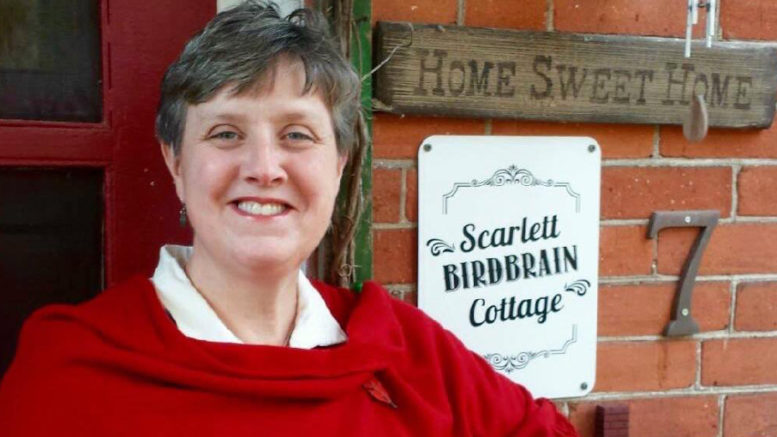Laurie Snider
Notes from the Nest
I’ve just spent a very enjoyable afternoon with my very altruistic, fun-loving daughter Ellie, stuffing itty bitty seeds, each adorned with long, white, fluffy hairs, into envelopes. We cracked jokes, giggled and chatted merrily away, like a pair of birds on a wire, making lighthearted work of the task in front of us.
The future buds we were so carefully packaging were, Aesclepios syriaca or common milkweed. Once they sprout, the plants will grow from two to five feet high, have thick, glossy leaves and produce large, round clusters of purplish, pink flowers. Milkweed is frequently found growing vigorously in ditches, meadows and agricultural fields.
It’s been used for medicinal purposes since ancient times, getting its name from, Aesclepios, the Greek god of medicine. If you snap its stem, a sticky, white sap immediately appears, thus the name milkweed. It also happens to be the sole food source for monarch butterfly caterpillars, making it a VIP (very important plant!)
Monarch butterflies or Danaus Plexippus, (meaning “sleepy transformation”) with their showy, orange and black wings are one of the most recognizable species in Canada. The North American eastern population of monarchs are small but mighty, weighing in at less than a gram.
These marvels of nature, perform a multigenerational migration, that spans three countries and up to a distance of 5,000 km, longer than any other insect.
First generation monarchs are the offspring of the ones which over-winter in Mexico. A second generation is then born in the early spring, in the central United States and heads north, as the milkweed supply there ends. Generation No. 3 is born in their northern breeding range, in southern Canada.
The fourth generation of these extraordinary creatures doesn’t have the urge to reproduce at all. They put their energy into creating stores of fat for an improbable journey back southward to their winter getaway, again in Mexico. With no road maps and no GPS, these truly remarkable flyers find their way, an incredible feat considering they’ve never been before! Most adult butterflies mate, lay eggs and live for about a month. These fourth-generation migrators live for about nine months, until the cycle repeats all over again.
Female monarchs lay their eggs on the underside of milkweed leaves, which she identifies by scratching the surface and then smelling the plant. Over a few weeks, she may lay 300 to 400 eggs. Life begins as a barely visible caterpillar. After munching on milkweed for two weeks, their mass increases by about 2,700 times, turning them into the 5 cm black, white and yellow striped wigglers we’re more familiar with.
Interestingly, milkweed contains toxins, which are taken in by the caterpillars while eating. It ends up making adult butterflies, taste terrible. Their bold colours serve as warnings to possible predators, to think before they bite, sort of like garlic and vampires!
After about two weeks, the caterpillars undergo several moults, before attaching themselves head down, to twigs and transforming into jade, green pupae with golden spots. If nothing else, monarchs have a keen fashion sense! Finally, with a shake and a flutter, a mere two weeks later, the breathtakingly, beautiful butterfly emerges, ready to play its part in this unimaginable circle of life.
In 1975, Dr Frank Urquhart, of the University of Toronto, began tagging monarchs. This led to the discovery of large roosts of them, in the Oyamel fir forests, in central Mexico’s, Sierra Nevada mountains. The millions of monarchs that congregate there are so vast, that the tree branches sag with their weight. In 2008, this monarch butterfly biosphere reserve was recognized as a UNESCO, world heritage site. Its protected area, covers 200 square miles.
Sadly, these phenomenal aviators are in trouble. While fluctuations in populations have occurred in the past, the eastern population recently, has been suffering consistently higher levels of mortality. Last year the Committee on the Status of Endangered Wildlife in Canada (COSEWIC), recommended that monarch’s status be changed from “Special Concern,” to “Endangered.”
The problems are the usual suspects; loss of habitat, use of pesticides, which have drastically reduced milkweed and nectar producing plants, illegal logging near their winter home, storms and climate change. We can help them though, by creating and preserving monarch habitats, using nature friendly products in our yards, supporting conservation efforts, to protect and restore habitat, here and in their over-wintering grounds and by planting milkweed and nectar plants, as food sources for them.
This Saturday, at the town market, we will be giving away locally-sourced, milkweed seeds that I gathered last fall. If you’d like to help protect this fantastically, fascinating species, by planting some in your own garden, then we’d be pleased to see you. Goodness knows, the monarchs would be most grateful, if you can lend a hand.

